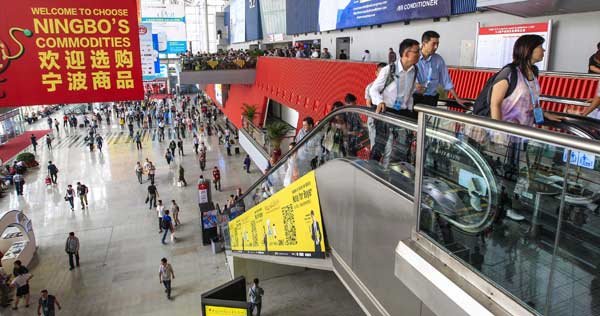Yangtze businesses getting creative
In recent weeks, surveys and studies all seem to be pointing to an economic upswing. Even the international investment banks that have been talking down China are changing their tune.
Of course, many concerns have not disappeared. But business confidence has shown signs of picking up. That is particularly obvious among the thousands of private-sector entrepreneurs in the Yangtze River Delta region that produce a wide range of consumer goods for export around the world.
They are the force expected to play a key role in spearheading China's restructuring from a low-cost production base to a high-value-added manufacturing hub. But they aren't of much use when wallowing in despair and self-pity, as they have been doing over the past several months.
Now, some say they are seeing a ray of hope.
|
 The official statistics from the 114th China Import and Export Fair (Canton Fair) showed that total export turnover at the fair totaled about 194.6 billion yuan ($31.9 billion), a drop of 10.9 percent from the spring fair in April and 3 percent lower than the same period last year. Provided to China Daily |
"I feel much better than I did a year ago," said Li Zijian, owner of Zhejiang Ruolai Trading Co Ltd in Jinhua, Zhejiang province. He and other area factory owners said that although overseas orders are still sluggish, more buyers are coming to talk business. What's more, they said they've benefited from having more working capital by running down inventories.
"We haven't been so lean and mean for a long time," Li said.
Today, manufacturers, such as Li, will produce only as much as they can sell. Credit remains tight, Li said. But "we are in a better position than before to manage that," he added.
More important, many manufacturers learned a hard lesson in the recent business downturn and credit squeeze. Realizing that the old business model doesn't work in an environment of rising labor and land costs, some manufacturers are investing in upgrades to their operations and exploring new markets.
The official statistics from the 114th China Import and Export Fair (Canton Fair) showed that total export turnover at the fair totaled about 194.6 billion yuan ($31.9 billion), a drop of 10.9 percent from the spring fair in April and 3 percent lower than the same period last year. Among signed orders, 48.9 percent were short-term ones of fewer than three months, while only 16.2 percent were long-term orders of more than six months.
Overseas demand hasn't come back strongly, while more enterprises are racing to upgrade and restructure their companies to obtain advantages and attract clients from abroad, Liu Jianjun, spokesperson for the fair and the deputy general of China Foreign Trade Center said at the fair's closing ceremony.
For privately owned enterprises, turnover also fell 10.4 percent from April and decreased 7.5 percent compared with the previous year, fair data showed.
"All the orders for this year I've signed are smaller and for shorter terms from nearly the same amount of clients compared with the previous year, which indicates the overseas market hasn't recovered yet," said Yang Xiaolong, chairman of Zhejiang Gete Clothes Co Ltd in Wenzhou, who had just returned from the Canton Fair.
He added that foreign clients breached contracts to avoid risk when fluctuations in raw material prices and exchange rates got too large from time to time.
To counteract a nearly 50 percent drop in orders compared with two years ago, Yang managed to find five new clients in Russia, South America and the Middle East to make up the loss through the whole year to maintain business operations.
"The export price kept declining for European countries in the past year, but the demands from newly emerging countries, such as those in South America, climbed," Yang said.
Yang noted that his profit margin improved slightly, growing about 5 percent, mainly due to booming markets in developing countries, while the European market still hasn't recovered.
"The shrinking export orders and tougher trade requirements from overseas have been quite noticeable - the company received far fewer orders from overseas, while close to 10 percent of regular clients didn't put in any new orders this year," said Zhang Guanjin, general manager of Shaoxing Jinyong Textile Co Ltd in Zhejiang.
Increased labor and material expenses forced the company to reduce the number of employees from 150 in 2011 to about 60.
In another move, Zhang switched his focus from overseas to the domestic market, getting comparatively fewer orders but with slightly higher prices.
"From the worst downturn of the previous year to the slow recovery of the global economy, the moderate growth in new export orders probably will benefit us sooner or later," he said.
yuran@chinadaily.com.cn


















